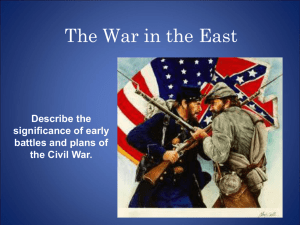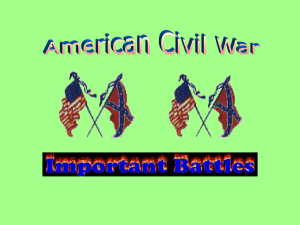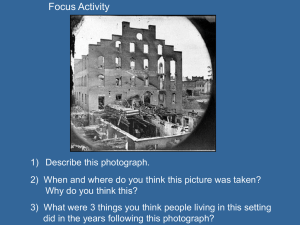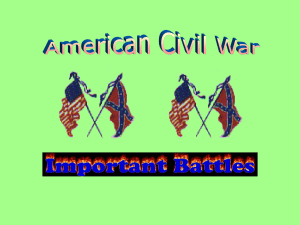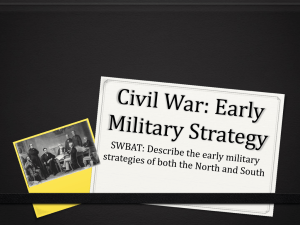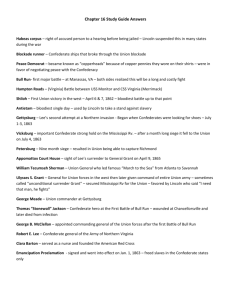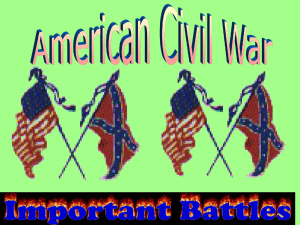Key Battles of the Civil War
advertisement
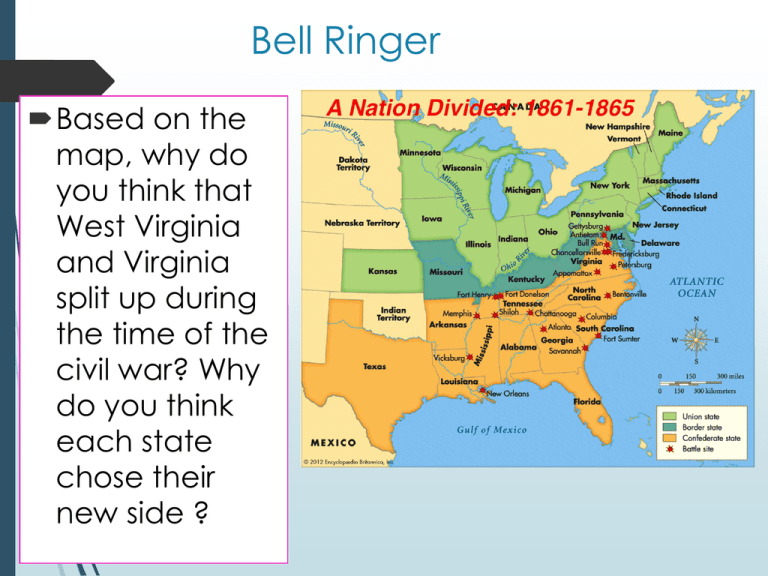
Bell Ringer Based on the map, why do you think that West Virginia and Virginia split up during the time of the civil war? Why do you think each state chose their new side ? Brain Pop: Civil War Follow the instructions on your foldable. In each box you will need to include: -Summarize (What was the significance?) -Dates -Names -Locations -Outcome (Who Won?) The first engagement of the Civil War took place at Fort Sumter on April 12 and 13, 1861. After 34 hours of fighting, the Union surrendered the fort to the Confederates. From 1863 to 1865, the Confederates at Fort Sumter withstood a 22 month siege by Union forces. During this time, most of the fort was reduced to brick rubble. Fort Sumter Charleston Harbor, South Carolina Union Commander Anderson : Major Confederate Commander: General Beauregard April 12-14, 1861 Casualties: None Winner: Confederate Significance: •First battle of Civil War. •Raised false hopes for a quick war. •Lincoln then asked for 100,000 volunteers. •General Beauregard was a student of Major Anderson while at Westpoint Fort Sumter* First Battle of Bull Run* Public demand pushed General-in-Chief Winfield Scott to advance on the South before adequately training Union troops. Scott ordered General Irvin McDowell to advance on Confederate troops stationed at Manassas Junction, Virginia. McDowell attacked on July 21, and was initially successful, but the introduction of Confederate reinforcements resulted in a Southern victory and a chaotic retreat toward Washington by federal troops. Stonewall Jackson* First Battle of Bull Run Manassas, Virginia Union Commander: General Irwin McDowell Confederate Commander: General Joe Johnston July 21, 1861 Casualties: Union-2,446, Confederate1,600 Winner: Confederate Significance of Bull Run : •First large battle of the war. •Confederates routed an unprepared Union force. •Casualties shocked the North and South. •They now believed the war would not be quick nor easy. •During this battle, General Thomas J. Jackson earned the name, “Stonewall” by inspiring his troops to stand firm under the Union attack. Shiloh was a decisive and bloody battle. The South needed a win to make up defeats in Kentucky and Tennessee and needed to stop the Union’s attack down the Mississippi Valley. Memphis and Vicksburg were now vulnerable and after Corinth there was doubt that those cities would be targets. Johnston and Beauregard made a surprise attack while the Union rested. Grant and his men lost their over-confidence after this near defeat. They now knew that this war was going to be, in the words of a Union Soldier, "A very bloody affair." The Confederacy caught General Grant by surprise and almost destroyed his army the first day. On the second day Grant was reinforced and forced the Confederates back to Corinth. Shiloh, Tennessee Union Commander: General Ulysses Grant Confederate: General Albert Sydney Johnston April 6-7, 1862 Casualties: Union-13,047 Confederate-10,694 Shiloh* Significance: •Ended the Southern hope of ever regaining Tennessee. •The first battle with truly large casualties. •Grant temporarily lost his position in command. •Greatly slowed the Union advance down the Mississippi valley To the right is a monument where he fell. General Albert Sydney Johnston was considered the finest general in either army before the war began. He bled to death on the first day of Shiloh from a wound to the leg while leading a charge through an orchard. The single bloodiest day of the Civil War Lee invaded Maryland hoping the state would help the South. Instead, Lee was pinned down at Antietam creek by George McClellan after his plans were discovered wrapped around some cigars. 2nd Bullrun Antietam Creek Sharpsburg, Maryland Union Commander: General George McClellan Confederate Commander: General Robert E. Lee September 17, 1862 Casualties: Union-12,410 Confederate-13,724 Winner: Union…barely! Battle of Antietam* Significance: •One of only 2 major battles fought in the North. •The bloodiest day of the war. •The Union forced Lee back to the South. •This victory was what Lincoln needed to issue the Emancipation Proclamation. General Joseph Hooker took control of the Union Army after General Burnside made his blunder at Fredericksburg. One part of his army crossed the Rappahannock south of Fredericksburg, the other crossed the river 12 miles to the north at Chancellorsville. Hooker successfully outflanked Lee. Or so he thought…. At 6 PM on May 2nd, Jackson launched his attack on the unsuspecting Union flank. Jackson was wounded by his own men, he died a few days later. Hooker ordered his forces to attack from the south and they were successful in driving back the rebels. This force was ordered to advance and attack Lee's main body from the rear. Unfortunately, the inactivity of Hookers forces in front of Lee allowed him to turn his army to the rear. The Union forces were forced back across the Rappahannock. Once again Lees superior generalship and Union incompetence had bested a Union forces twice his size. Joseph Hooker Lee Chancellorsville, Virginia Union Commander: General Joseph Hooker Confederate Commander: Robert E. Lee May 1-4, 1863 Casualties: Union-17,278 Confederates-12,821 Winner: Confederacy Battle at Chancellorsville* Significance: •Hooker was out maneuvered by Lee and Stonewall Jackson. •Considered the greatest Confederate victory of the war. •Stonewall Jackson was accidently shot by his own troops. He died a week later. At the time of the Civil War, the Mississippi River was the single most important economic feature of the continent. Confederate forces closed the river, which hurt the northern economy. Grant realized that Vicksburg could not be taken by storm and decided to lay siege to the city. Slowly his army established a line of trenches and dirt forts around Vicksburg and cut it off from supply and communications with the outside world. Starting in May Union forces constructed thirteen trenches aimed at different points along the Confederate defense. In June they dug up to the Confederate line, tunneled underneath, and blew up the tunnels filled with black powder to destroy the rebel trenches. The rebels were out of food, out of ammunition and they were clearly losing. They surrendered on July 4th. Vicksburg, Mississippi Union Commander: General Ulysses Grant Confederate: General Joseph E. Johnston May 19- July 4 1863 Casualties: Union Casualties: 10,142 Confederate Casualties: 9,091 Winner: Union Vicksburg Significance: •Grant was bogged down for 3 months •It was the most important victory in the west. •Vicksburg was the key to the Mississippi. •The Confederacy was split in two by the mighty river. - Little Roundtop Robert E. Lee Gettysburg, Pennsylvania Union Commander : General George Meade Confederate Commander: Robert E. Lee July 1-3, 1863 Casualties: Union-23,049 Confederate-28,063 Winner: Union After success at Fredericksburg and Chancellorsville, Lee invades the north again. After trying to break the union lines for 2 days, Lee tries a frontal assault on entrenched union forces. This was known as Pickett’s charge. This attempt failed miserably. Lee ultimately retreats to Virginia. Gettysburg* Significance: •The turning point of the war. •This would be the last chance for the South to win the war and threaten the North. Joshua Chamberlain. Former teacher turned hero at Gettysburg. Colonel Chamberlain and the 20th Maine held the extreme left flank of the Union line against a fierce rebel attack, and the surrender of Lee's Army of Northern Virginia at Appomattox, when Grant chose Chamberlain to receive the formal surrender of weapons and colors Atlanta, Georgia (Sherman’s march to the sea) Union Commander: General William Sherman Confederate Commander: General John Hood July 20-September 2, 1864 Casualties: Union-31,623 Confederate-35,044 Winner: Union Significance: The siege of Atlanta by General Sherman ended with the burning of the city by Union troops. After burning the city, Sherman began his famous march to the sea, during which his troops looted and plundered their way across Georgia, destroying nearly everything in their path. Surrender at Appomattox* On April 9, 1865 Robert E. Lee surrendered his army of Northern Virginia in a little village called Appomattox Courthouse. Lee surrendered formally to Ulysses S. Grant. The papers of formal surrender were signed in the home of Wilmer Mclean, whose first house was damaged during the first battle of the Civil War. Lee surrendered to Grant in this home.
